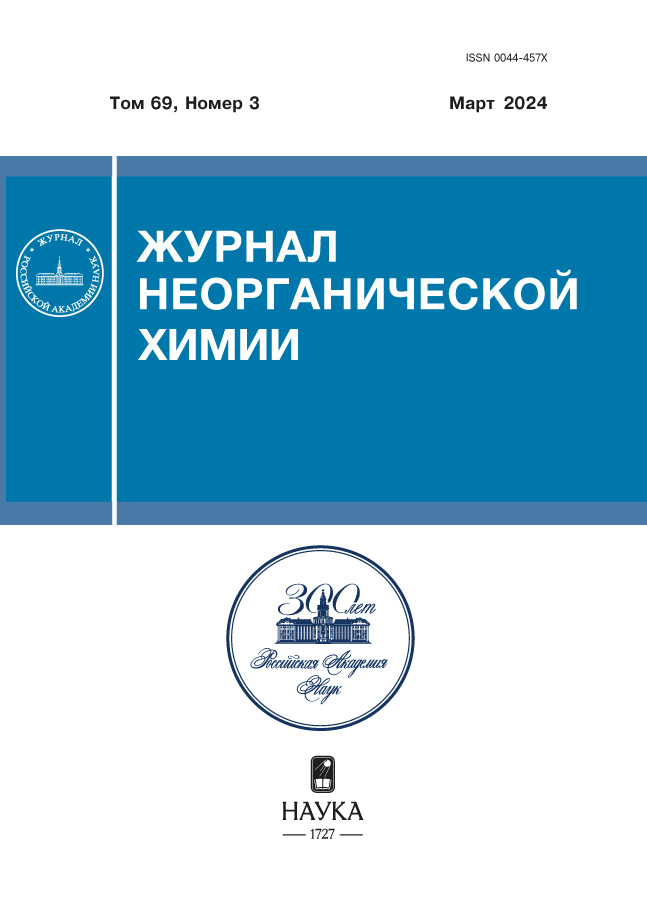Elastic Energy Relaxation During the Chemical Reaction with Single-Crystalline Silicon in the Process of Coordinated Substitution of Atoms
- 作者: Kukushkin S.A.1, Osipov A.V.1
-
隶属关系:
- Institute for Problems of Mechanical Engineering of Russian Academy of Sciences
- 期: 卷 69, 编号 3 (2024)
- 页面: 319-326
- 栏目: SYNTHESIS OF ADVANCED CARBON MATERIALS
- URL: https://kld-journal.fedlab.ru/0044-457X/article/view/666596
- DOI: https://doi.org/10.31857/S0044457X24030065
- EDN: https://elibrary.ru/YEOUXE
- ID: 666596
如何引用文章
详细
This study focuses on providing a detailed microscopic description of the chemical transformation of a silicon crystal into a silicon carbide crystal through reaction with carbon monoxide gas on the (111) surface. To achieve this, we utilized the density functional theory in the spin-polarized PBE approximation. By employing the NEB method, we successfully established all intermediate (adsorption) states as well as a single transition state. Our results rэВeal that the transition state takes the form of a Si-O-C triangle, with bond lengths measuring 1.94 Å, 1.24 Å, and 2.29 Å. Additionally, we calculated the energy profile of this chemical transformation. Interestingly, we discovered that the formation of broken bonds generates both electric and magnetic fields during the transformation process. Furthermore, our findings indicate that the relaxation of elastic energy plays a significant role in facilitating the epitaxial growth of the crystal by weakening the bonds of necessary atoms. Consequently, we conclude that the (111) surface is highly suitable for silicon carbide growth via this method, particularly for semiconductor applications.
全文:
作者简介
S. Kukushkin
Institute for Problems of Mechanical Engineering of Russian Academy of Sciences
编辑信件的主要联系方式.
Email: sergey.a.kukushkin@gmail.com
俄罗斯联邦, Saint Petersburg
A. Osipov
Institute for Problems of Mechanical Engineering of Russian Academy of Sciences
Email: sergey.a.kukushkin@gmail.com
俄罗斯联邦, Saint Petersburg
参考
- Ferro G. // Crit. Rev. Solid State Mater. Sci. 2015. V. 40. № 1. P. 56. https://doi.org/10.1080/10408436.2014.940440
- Severino A., Locke C., Anzalone R. et al. // ECS Trans. 2011. V. 35. № 6. P. 99. https://doi.org/10.1149/1.3570851
- Kukushkin S.A., Osipov A.V. // J. Appl. Phys. 2013. V. 113. № 2. https://doi.org/10.1063/1.4773343
- Kukushkin S.A., Osipov A.V. // Russ. J. Gen. Chem. 2022. V. 92. № 4. P. 584. https://doi.org/10.1134/S1070363222040028
- Kukushkin S.A., Osipov A.V. // Phys. Solid State. 2016. V. 58. № 4. P. 747. https://doi.org/10.1134/S1063783416040120
- Kukushkin S.A., Osipov A.V., Feoktistov N.A. // Phys. Solid State. 2019. V. 61. № 3. P. 456. https://doi.org/10.1134/S1063783419030193
- Kukushkin S.A., Osipov A.V. // Materials (Basel). 2022. V. 15. № 13. P. 4653. https://doi.org/10.3390/ma15134653
- Kukushkin S.A., Osipov A.V., Soshnikov I.P. // Rev. Adv. Mater. Sci. 2017. V. 52. № 1–2. P. 29.
- Koryakin A.A., Kukushkin S.A., Osipov A.V. et al. // Materials (Basel). 2022. V. 15. № 18. P. 6202. https://doi.org/10.3390/ma15186202
- Kukushkin S.A., Osipov A.V. // Mech. Solids. 2013. V. 48. № 2. P. 216. https://doi.org/10.3103/S0025654413020143
- Kukushkin S.A., Osipov A.V., Telyatnik R.S. // Phys. Solid State. 2016. V. 58. № 5. P. 971. https://doi.org/10.1134/S1063783416050140
- Ермакова Е.Н., Максимовский Е.А., Юшина И.В. и др. // Журн. неорган. химии. 2023. Т. 68. № 2. С. 256. https://doi.org/10.31857/S0044457X22601547
- Воронцов Е.С. // Успехи химии. 1965. Т. 34. № 11. С. 2020.
- Dovesi R., Civalleri B., Roetti C. et al. Ab Initio Quantum Simulation in Solid State Chemistry in Rev. Comput. // ChemInform. V. 36. № 48. P. 1. https://doi.org/10.1002/0471720895.ch1
- Tuan Hung N., Nugraha A.R.T., Saito R. Quantum ESPRESSO Course for Solid State Physics. N.Y.: Jenny Stanford Publishing, 2022. 372 p. https://doi.org/10.1201/9781003290964
- Lee J.G. Computational Materials Science: An Introduction, Boca Raton: CRC Press, 2016. 376 p. https://doi.org/10.1201/9781315368429
- Сангвал К. Травление кристаллов: Теория. Эксперимент. Применение: Пер. с англ. М.: Мир, 1990. 492 с.
- Kukushkin S., Osipov A., Redkov A. // Adv. Struct. Mater. 2022. V. 164. P. 335. https://doi.org/10.1007/978-3-030-93076-9_18
- Kukushkin S.A., Osipov A.V. // J. Phys. D: Appl. Phys. 2014. V. 47. № 31. https://doi.org/10.1088/0022-3727/47/31/313001
- Kukushkin S.A., Osipov A.V. // Materials (Basel). 2021. V. 14. № 1. P. 78. https://doi.org/10.3390/ma14010078
- Henkelman G., Uberuaga B.P., Jónsson H. // J. Chem. Phys. 2000. V. 113. № 22. P. 9901. https://doi.org/10.1063/1.1329672
- Tolédano P., Dmitriev V. Reconstructive Phase Transitions, World Scientific, 1996. 416 p. https://doi.org/10.1142/2848
补充文件

















